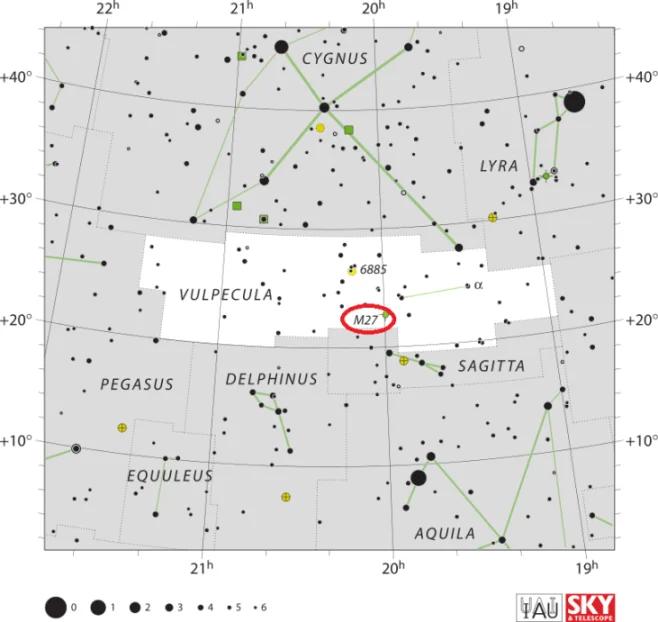Messier 27 (M27), also known as the Dumbbell Nebula, Diabolo Nebula or Apple Core Nebula, is a planetary nebula in Vulpecula. The Dumbbell Nebula is large in size and quite bright, which makes it a popular object among amateur astronomers. It can be seen in binoculars and small telescopes.
The nebula covers an area of 8 by 5.6 arc minutes of the apparent sky and has a linear radius of 1.44 light years. Its faint halo stretches out to more than 15 arc minutes. M27 lies at an approximate distance of 1,360 light years, or 417 parsecs, from Earth and has an apparent magnitude of 7.5. It has the designation NGC 6853 in the New General Catalogue.
Messier 27 is the second brightest planetary nebula in the sky, second only to the Helix Nebula in Aquarius, and probably the easiest one to observe because it has a higher surface brightness than the Helix and is therefore easier to find.
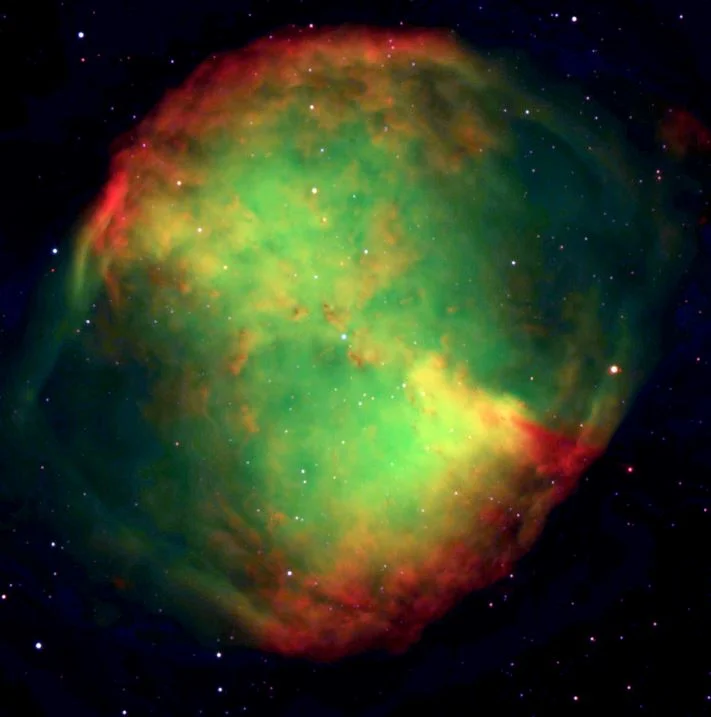
This image is the beautiful by-product of a technical test of some FORS1 narrow-band optical interference filtres. They only allow light in a small wavelength range to pass and are used to isolate emissions from particular atoms and ions. In this three-colour composite, a short exposure was first made through a wide-band filtre registering blue light from the nebula. It was then combined with exposures through two interference filtres in the light of double-ionized oxygen atoms and atomic hydrogen. They were colour-coded as “blue”, “green” and “red”, respectively, and then combined to produce this picture that shows the structure of the nebula in “approximately true” colours. Image: ESO
The Dumbbell Nebula lies just to the south of the star 14 Vulpeculae. It can be seen in large binoculars, and some of its details are visible even in smaller telescopes. The best time of year to observe M27 is summer as it lies within the Summer Triangle, a prominent asterism in the summer sky formed by the bright stars Altair in Aquila constellation, Vega in Lyra and Deneb in Cygnus.
The nebula lies about a quarter of the way from Altair to Deneb. Aquila and Cygnus are easy to make out in the night sky because the two bird constellations, representing the Eagle and the Swan, are high overhead in the summer and lie opposite to each other. Cygnus is particularly prominent and easy to identify because its brightest stars form the Northern Cross, another familiar summer asterism.
Visually, the Dumbbell Nebula appears white even in larger telescopes, but its two-lobed shape is clear. The nebula’s details can be revealed by colour astrophotography.
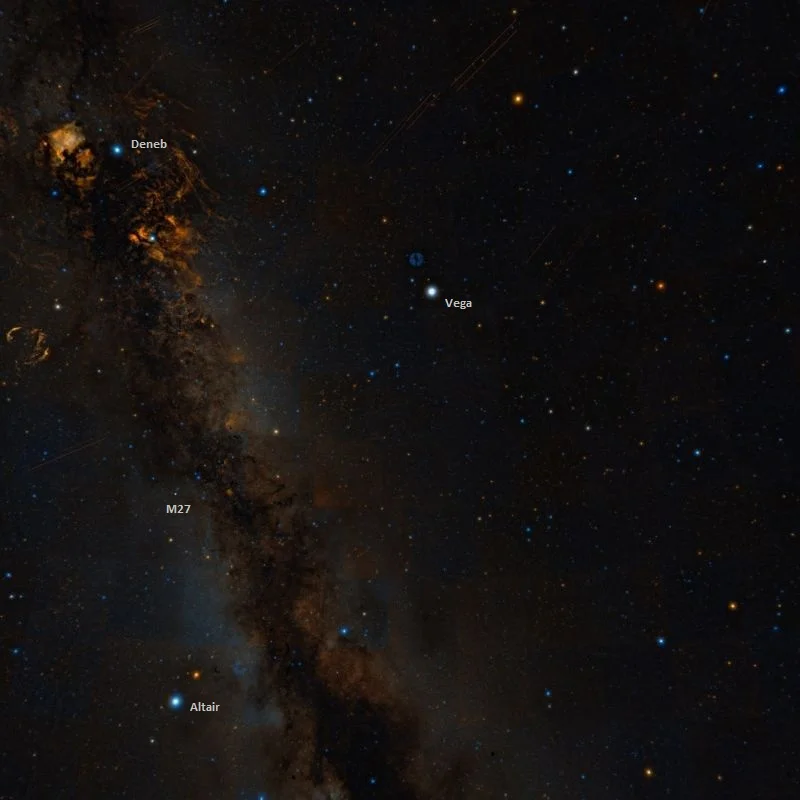
Planetary nebulae are what our Sun will produce when it nears the end of its life and nuclear fusion stops in its core. These nebulae are formed when evolved giant stars eject their outer envelopes, exposing the hot core of the star, which then ionizes the surrounding cloud of expelled material with ultraviolet light. The clouds keep expanding until they dissipate into the surrounding space.
The central region of M27 contains dark and bright knots which vary in size and shape. Some are symmetrical and have tails while others do not. The knots are anywhere from 17 to 56 billion kilometres (11 to 35 billion miles) in size and each of them has a mass three times that of our planet.
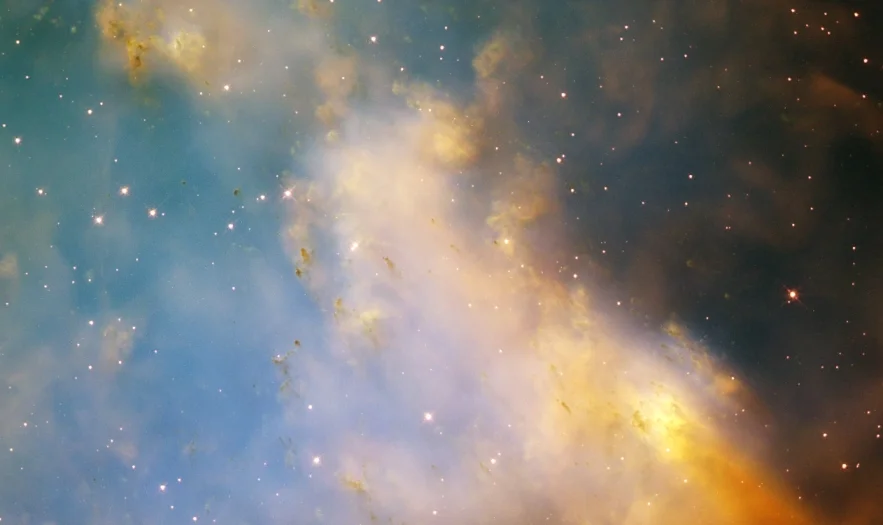
Messier 27 was the first ever planetary nebula to be discovered. Charles Messier found it on July 12, 1764 and described it as a “nebula without star” that “appears of oval shape.” In the first Messier catalogue (1771), he wrote:
On July 12, 1764, I have worked on the research of the nebulae, and I have discovered one in the constellation Vulpecula, between the two forepaws, & very near the star of fifth magnitude, the fourteenth of that constellation, according to the catalog of Flamsteed: One sees it well in an ordinary refractor of three feet & a half [FL]. I have examined it with a Gregorian telescope which magnified 104 times: it appears in an oval shape; it doesn’t contain any star; its diameter is about 4 minutes of arc. I have compared that nebula with the neighboring star which I have mentioned above [14 Vul]; its right ascension has been concluded at 297d 21′ 41″, & its declination 22d 4′ 0″ north.
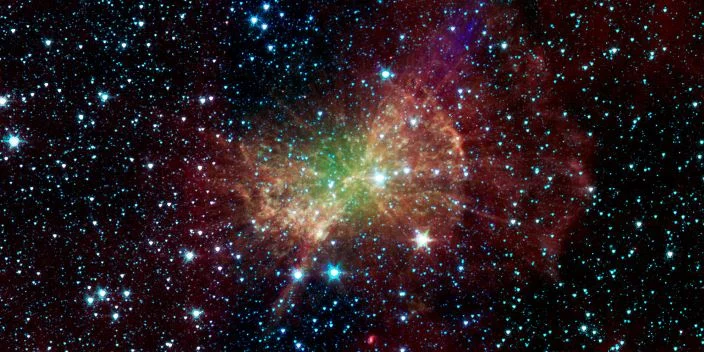
John Herschel first described the nebula after seeing it on August 24, 1827:
Place the most condensed part of the southern head; diameter in RA = 25.0s. A most extraordinary object; v B [very bright]; an unresolved nebula, shaped something like an hour-glass, filled into an oval outline with a much less dense nebulosity. The central mass may be compared to a vertebra or a dumb-bell. The southern head is denser than the northern. One or two stars seen in it.
Herschel observed the nebula again on August 17, 1828 and noted:
A nebula shaped like a dumb-bell, with the elliptic outline completed by a feeble nebulous light. Position of the axis of symmetry through the centres of the two chief masses = (by microm.) 30.0deg .. 60.0 deg nf..sp. The diam of the elliptic light fills a space nearly equal to that between the wires (7′ or 8′). Not resolvable, but I see on it 4 distinct stars 1 = 12 m at the s f edge; 2 = 12.13 m, almost diametrically opposite; 3 = 13 m in the n p quarter, and 1 = 14.15 m near the centre. Place that of the centre.
Herschel catalogued the Dumbbell Nebula as h 2060 and added it to his General Catalogue of Nebulae and Clusters as GC 4532.
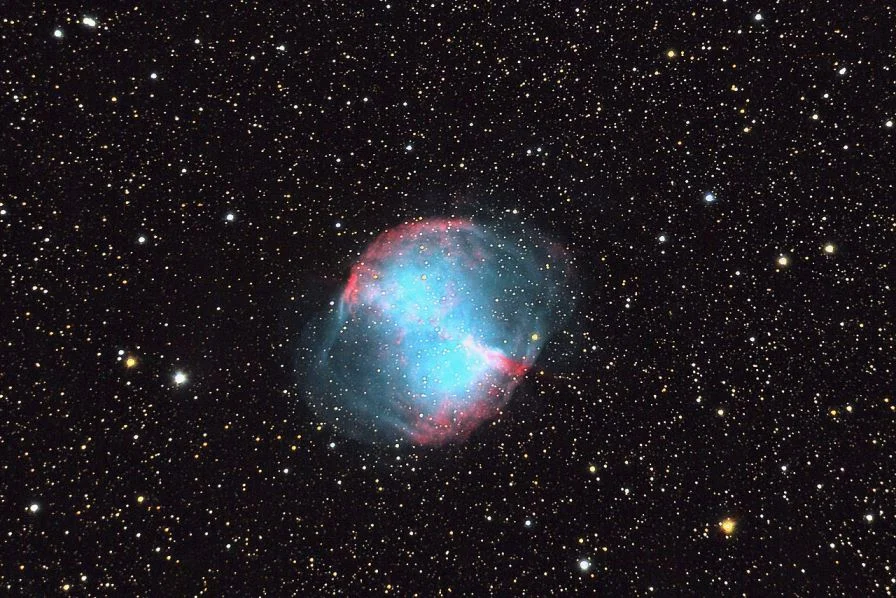
Admiral William Henry Smyth offered the following observation in August 1834:
This is the double-headed shot or dumb-bell nebula, on the Fox‘s breast, close to 14 Vulpeculae; it is about 7deg to the south-east of Beta Cygni, and nearly half-way between it and the Dolphin. This magnificent and singular object is situated in a crowded vicinity, where field after field is very rich. It was discovered in 1764, and described by Messier as an oval nebula without stars. My instruments, however, show several, of which three, lying sp [south preceding, SW] and nf [north following, NE], nearly in the same direction with the dumb-bell, and 26s distant, following, are sufficiently remarkable: the two largest are of the 8 and 9 1/2 magnitude, and 6s apart, on an angle = 73deg, the latter having a small reddish telescopic companion nf [north following, NE].
The estimated age of M27 is under 14,600 years. The Dumbbell Nebula expands at a rate of up to 2.3 arc seconds per century. The bright central section is expanding at a rate of 6.8 arc seconds per century, which gives the nebula an estimated age of 3,000 to 4,000 years. In 1970, a group of researchers calculated an expansion velocity of 31 km/s, which would put the nebula’s kinetic age at 9,800 years.
The nebula has the shape of a prolate spheroid and appears along the plane of its equator when seen from Earth, similar to another Messier object. Messier 76, nicknamed the Little Dumbbell Nebula, also appears from its equatorial plane but is slightly fainter. M76 is located in the constellation Perseus.
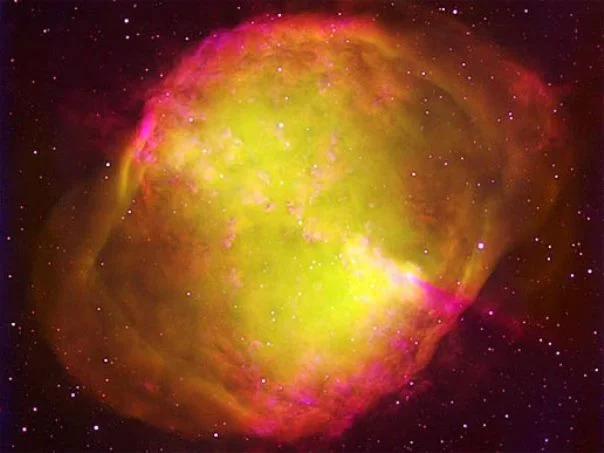
The Dumbbell Nebula (M27) and the Little Dumbbell Nebula (M76) are two of only four planetary nebulae listed in Messier’s catalogue. The remaining two are the famous Ring Nebula (M57) in the constellation Lyra and the Owl Nebula (M97) in Ursa Major.
The central star in the Dumbbell Nebula is a white dwarf with with a visual magnitude of 13.5 and a radius of 0.055 solar radii, which makes the star the largest white dwarf known.
The star has an estimated mass of 0.56 solar masses. It is an extremely hot bluish star with an estimated temperature of 85,000 K. The star is believed to have a companion: a faint, magnitude 17 yellowish star separated by 6.5 arc seconds from the white dwarf.
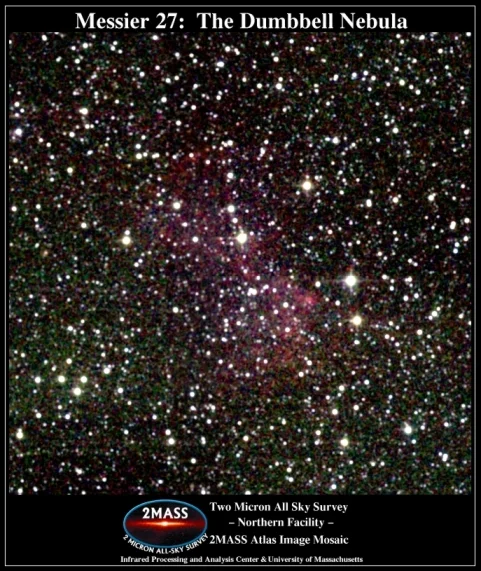
The Dumbbell Nebula is more than 100 times more luminous than our Sun, while the central star has only about a third of the Sun’s luminosity and the companion is almost 100 times fainter. The nebula is brighter than the star itself because the star mainly emits in the non-visible part of the spectrum and then the nebula absorbs the radiation and emits much of it in visible light.
In 1988, Leos Ondra, a Czech amateur astronomer, discovered a variable star that appeared in some images of M27 but not in others. He concluded that it was a long period variable and nicknamed it Goldilocks.
The Goldilocks Variable was later confirmed to be a Mira-type variable, a pulsating star going through a cycle of expansion and contraction every 213 days. Mira variables were named after Mira, also known by its Bayer designation Omicron Ceti, a red giant star located in the constellation Cetus, the Whale.
The Goldilocks Variable is not in the Dumbbell Nebula, but lies much farther away. It can be seen in the distance because M27 is partially transparent.
An open cluster can be found about 2 degrees west of M27. Designated NGC 6830, the cluster has about 20 to 30 stars and lies at a distance of 5,500 light years.
FACTS
| Object: Nebula |
| Type: Planetary |
| Designations: Messier 27, M27, Dumbbell Nebula, Apple Core Nebula, Diabolo Nebula, NGC 6853, Hen 2-452, BD+22 3878, CSI+22-19572, EUVE J1959+22.7, WD 1957+225, PN VV 246, PN ARO 14, PN VV’ 521, PK 060-03, RX J1959.6+2243, GCRV 12336, GC 4532, h 2060 |
| Features: Central white dwarf has the largest known radius in its stellar class |
| Constellation: Vulpecula |
| Right ascension: 19h 59m 36.340s |
| Declination: +22°43’16.09” |
| Distance: 1,360 light years (417 parsecs) |
| Apparent magnitude: 7.5 |
| Absolute magnitude: -0.6 |
| Apparent dimensions: 8′ x 5′.6 |
| Radius: 1.44 light years |
LOCATION
